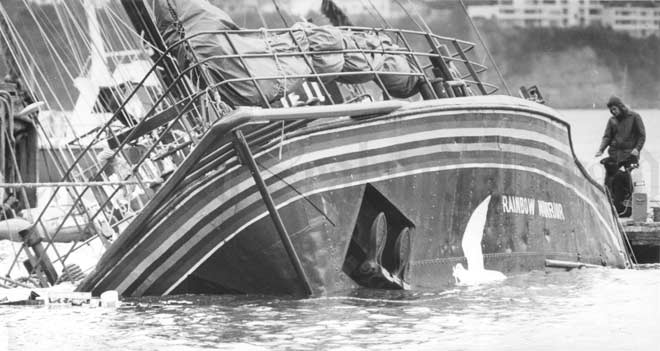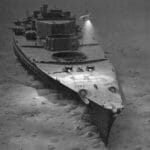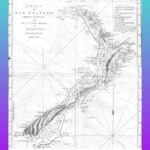The Greenpeace Flagship and a Deadly Act of Sabotage
Imagine a symbol of peace, a ship dedicated to environmental activism, lying shattered by a bomb in a peaceful harbor. This devastating scene became a reality on July 10, 1985, when the Greenpeace flagship Rainbow Warrior was sunk in Auckland, New Zealand. The attack sent shockwaves around the world, raising questions about who would target a peaceful organization and why. The answer exposed a chilling truth: state-sponsored terrorism driven by a desperate attempt to silence dissent.
Unveiling the Truth: Why Did They Sink the Rainbow Warrior?
The Rainbow Warrior, a beacon for Greenpeace, was preparing for a voyage to Mururoa Atoll in the Pacific Ocean. Their mission: to protest French nuclear testing and expose the potential environmental devastation. This act of defiance likely stirred unease within the French government, but no one could have predicted the events that would unfold.
In July 1985, the world watched in disbelief as news broke of the Rainbow Warrior’s sinking in Auckland harbor. It was no accident – a bombing had ripped through the ship, tragically taking the life of photographer Fernando Pereira. The attack served as a grim reminder that even peaceful protest could carry deadly consequences.
Evidence quickly pointed toward France, facing mounting pressure to halt its nuclear tests. International condemnation and Greenpeace’s unwavering opposition put France in a difficult position. Some experts suggest that sinking the Rainbow Warrior was a desperate attempt to silence their critics and protect their nuclear ambitions, regardless of the cost.
The global response to the bombing was immediate and furious. While France initially denied any involvement, the weight of evidence forced them to admit their role. The damage to their international reputation was immense, and their relationship with New Zealand suffered greatly.
The operation, codenamed “Opération Satanique,” revealed a plot seemingly ripped from a spy thriller. France had deployed secret agents, disguised as tourists, to sabotage the ship. Posing as an ordinary couple, these agents planted bombs on the Rainbow Warrior, ultimately leading to its tragic demise.
Two agents were caught and charged with manslaughter. This event ignited the global anti-nuclear movement, propelling the issue into the spotlight and revealing the lengths to which some would go to silence opposition. The risks faced by environmental activists were starkly exposed.
While the Rainbow Warrior now rests beneath the waves, its story continues to resonate. It serves as a powerful symbol of the environmental movement, a reminder that protecting our planet is a fight worth having, even when met with such devastating adversity. The voice of dissent, it seems, will not be silenced.
Did France’s Apology for the Rainbow Warrior Go Far Enough?
France’s response to the Rainbow Warrior bombing was complex, marked by delays, evolving narratives, and lingering questions. Their initial reaction was a complete denial of any involvement, but as international pressure intensified, France was forced to admit its role.
The apology itself was multifaceted. A formal statement acknowledging responsibility was issued, and reparations were paid to New Zealand, Greenpeace, and the family of Fernando Pereira. However, many felt that these actions, however substantial, were insufficient. The delayed admission of guilt left many skeptical of France’s sincerity, feeling that they had tried to evade responsibility for as long as possible.
Years later, the waters grew murkier. Jean-Luc Kister, a French agent involved in the bombing, issued a personal apology for his actions, adding another layer of complexity to the narrative. This apology, while significant, prompted further questions about the full extent of France’s accountability and the motivations behind the attack.
The Rainbow Warrior incident stands as a stark reminder of the potential for conflict between national interests and environmental activism. France, determined to protect its nuclear testing program, clashed with Greenpeace’s equally resolute mission to expose it. The result was a tragic loss of life and a legacy of unanswered questions.
Even with official apologies, reparations, and expressions of remorse, nothing can truly erase the events of that day. The memory of the Rainbow Warrior bombing serves as a potent symbol of the importance of accountability, transparency, and the fight to protect our environment, a fight that continues to this day.
Unveiling the “Rainbow Warrior” Tragedy: Your Guide to Outperforming the Competition
The Rainbow Warrior was more than just a ship; it was the embodiment of Greenpeace’s peaceful fight for a healthier planet. This vessel stood as a floating symbol against nuclear weapons and environmental destruction, capturing the world’s attention with its bold campaigns.
In 1985, the Rainbow Warrior was docked in New Zealand, preparing for a voyage to Mururoa Atoll, the site of French nuclear tests. However, this mission was tragically cut short. On July 10th, while peacefully docked in Auckland harbor, the ship was devastated by a bomb attack, sinking beneath the waves.
It soon came to light that French secret agents were responsible for the bombing, a shocking revelation that a government would resort to such extreme measures to silence peaceful protest. They were determined to prevent Greenpeace from interfering with their nuclear activities, even if it meant taking a life.
Tragically, the attack claimed the life of Fernando Pereira, a photographer for Greenpeace, who was trapped below deck when the bomb detonated. His death sparked global outrage and condemnation of France’s actions. While France eventually apologized and paid reparations, it did little to ease the pain of Pereira’s loss or erase the shocking nature of the attack.
The bombing of the Rainbow Warrior serves as a chilling reminder of the lengths to which some will go to silence opposition and protect their interests, even if it means resorting to violence against those peacefully advocating for a better world.
Where is the Rainbow Warrior Resting Today?
Following the tragic bombing, the Rainbow Warrior didn’t just disappear. Instead of fading into history, it embarked on a new journey, transforming from a symbol of protest into an underwater haven. Today, the ship’s remains lie 26 meters below the surface, near New Zealand’s Cavalli Islands, where it has become an artificial reef.
You might wonder how a deliberately sunk vessel could become a thriving marine environment. After the attack in Auckland harbor, the Rainbow Warrior was carefully relocated to its current location to create an artificial reef. The ship’s structure provides a hard surface – an underwater haven – attracting a diverse array of marine life.
Corals, sponges, and barnacles have made the ship their home, while fish seek shelter within its hull, transforming the wreck into a bustling underwater city. Divers who visit the site often describe it as hauntingly beautiful, witnessing nature reclaiming this once controversial vessel. It’s a powerful reminder of the cyclical nature of life and the resilience of the ocean.
But the Rainbow Warrior’s story doesn’t end there. It continues to serve as a poignant reminder of the importance of environmental protection. Each diver who visits, each fish that finds refuge within its hull, serves as a testament to the ship’s legacy and the ongoing fight for a healthier planet.
- Unlock 6000+ words beginning with he: A comprehensive analysis - April 20, 2025
- Mastering -al Words: A Complete Guide - April 20, 2025
- Master Scrabble: High-Scoring BAR Words Now - April 20, 2025

















1 thought on “The Sinking of the Rainbow Warrior: A Legacy of State-Sponsored Terrorism and Environmental Activism”
Comments are closed.